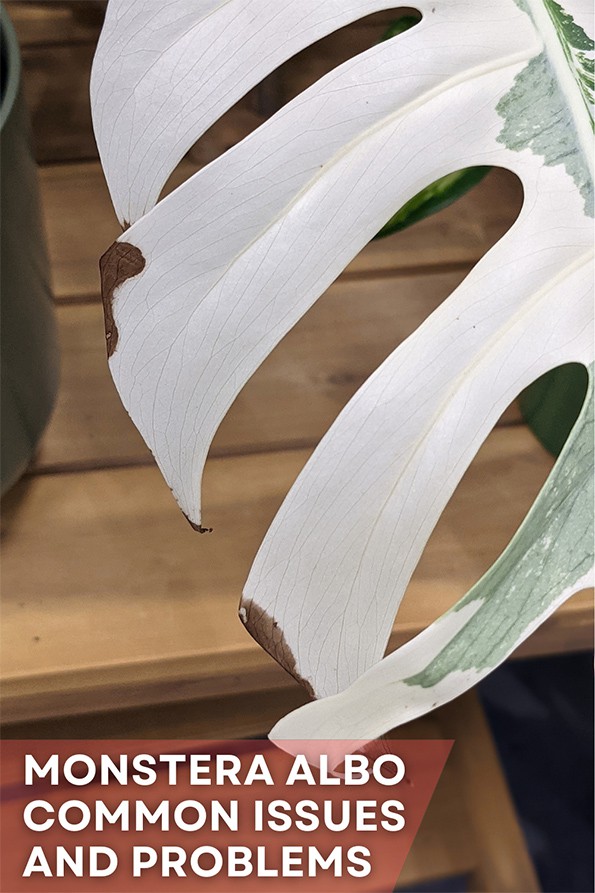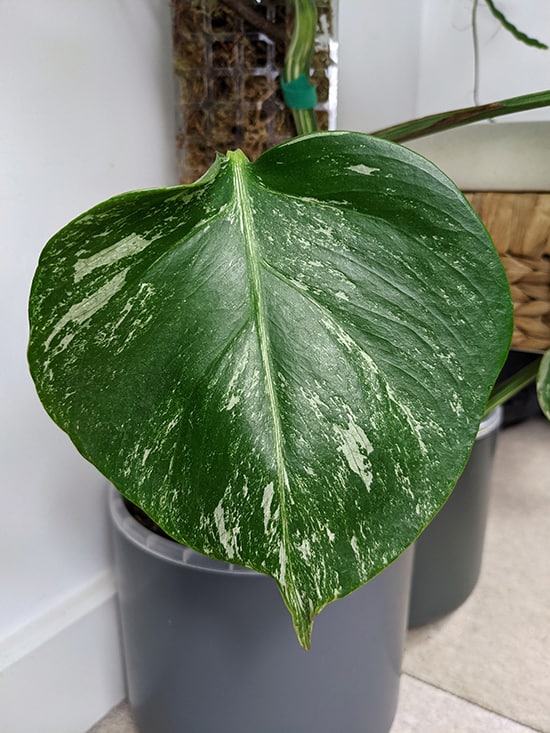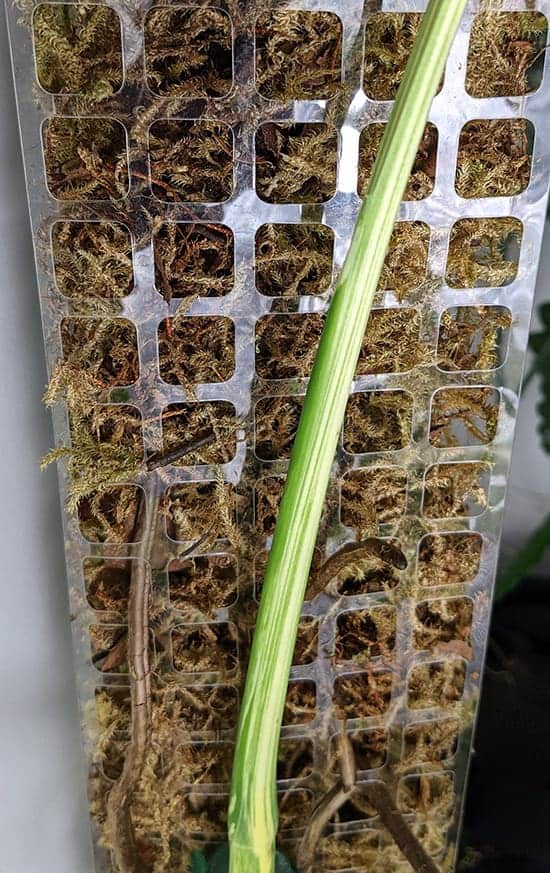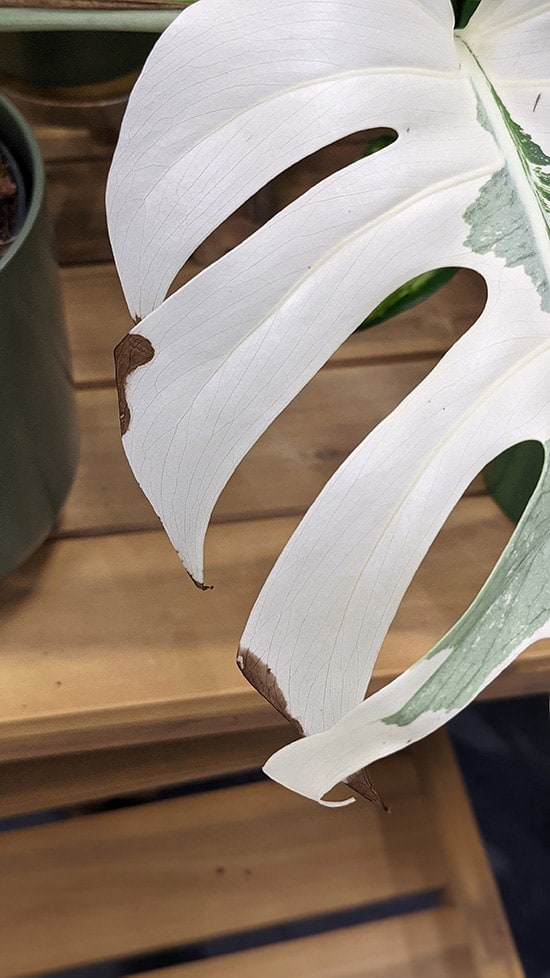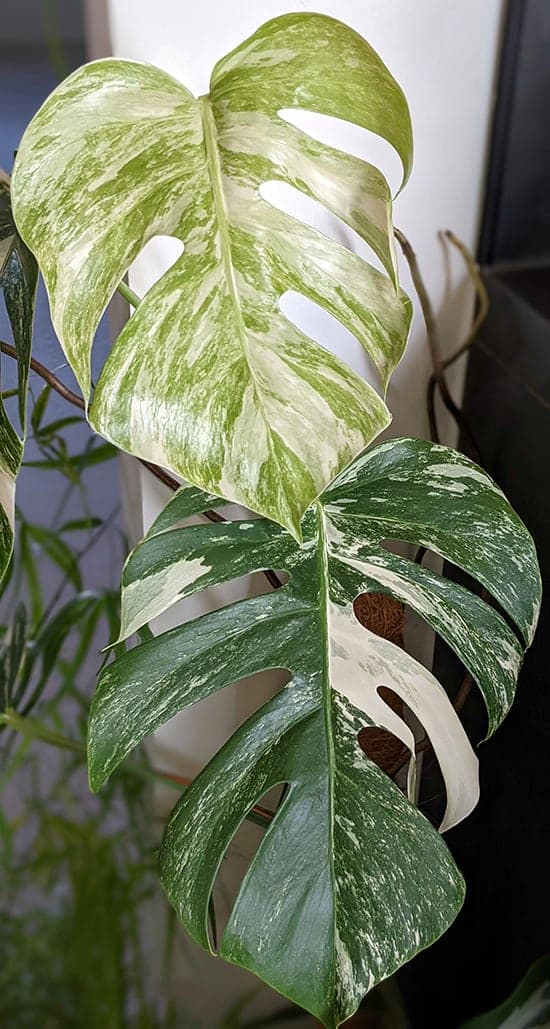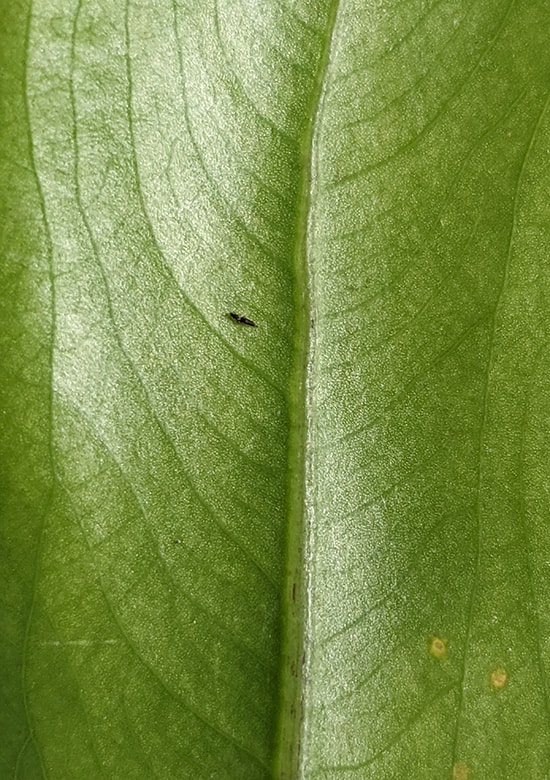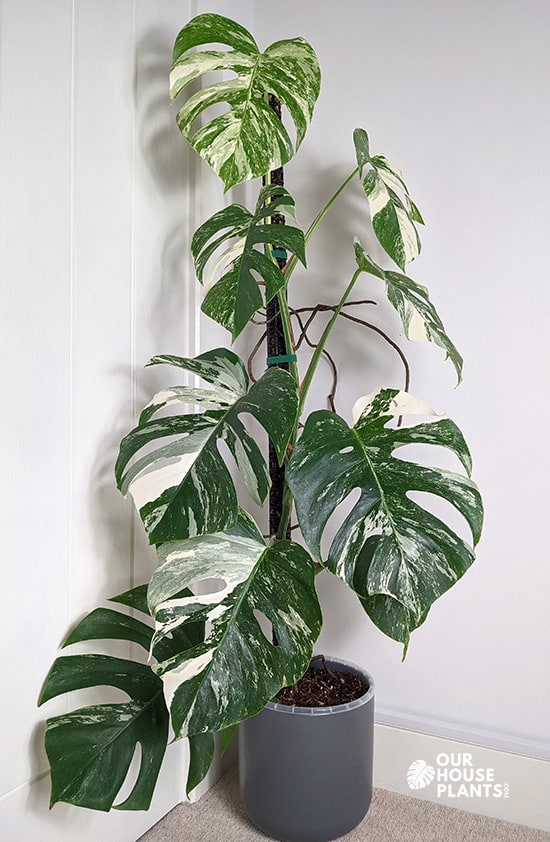By Tom Knight
Your Monstera Albo Problems Solved
Monstera Variegata Albo are reasonably easy going houseplants so problems and issues are pretty uncommon. But they're not foolproof and issues will still come up from time to time.
Some of the more common Monstera Albo problems I get asked about include yellowing leaves, root rot, browning edges, leggy growth, loss of variegation and pests.
The good news is that most of these issues can be fixed and the Albo often recovers. This guide will let you identify what's gone wrong and help you solve the problem.
Monstera Variegata Albo with brown markings on the white variegation. One of several common problems with these plants.
If you're pretty new to this houseplant, make sure you read through my complete care guide. If you stick to its care needs, this should help reduce or stop further issues.
If you've found this article already, you've probably got an issue that needs to be solved now. So, let's work out what's gone wrong and how to fix it.
Yellowing Leaves
Almost every houseplant leaf has a limited lifespan, after which the plant "unalives" it. This natural and normal response to aging triggers the plant to pull out all the nutrients and minerals and transports them to the rest of the plant for use.
Sometimes though, yellowing on your Monstera Variegata can be a sign of poor treatment.
Causes and How to Fix
Natural aging with yellow leaves is normal on mature plants. As described above, it should happen on the oldest leaves, which are usually right at the base of the plant. Additionally, it will likely be only one leaf doing this and then several months before another one starts yellowing.
If multiple leaves are doing at once or yellowing keeps happening in a short space of time then this is more likely to be caused by one of the following.
- Overwatering.
Excessive watering can lead to root rot, causing yellowing leaves. Ensure the top few inches of soil is dry before watering again and use well-draining soil. Get the watering needs right for your Albo and you'll save yourself these problems in the future.
- Underwatering.
Conversely, underwatering can also result in yellow leaves. Check if the soil is too dry and adjust your watering frequency.
- Nutrient Deficiency.
Lack of essential nutrients, particularly nitrogen, can lead to yellow leaves. Use a balanced fertilizer and follow recommended feeding schedules. Usually, this will be once a month or every two.
- Pests.
I cover the issue of Pests later on. The three suggestions above result in entirely yellow leaves, often with pests, the leaf will just have patches of yellowing, and if you look hard enough, you can often spot them.
Small Leaves
In general, Monstera plants will produce bigger and bigger leaves as they age. So, the next leaf is usually expected to be larger than the last. However, this is a general rule rather than a certain one.
Small leaf with no fenestrations on a variegated Monstera Albo plant. Various factors can affect the size of the leaves.
Causes and How to Fix
This is a fairly common question I get asked by new owners. Here are some of the most common reasons the plant will produce small leaves.
- Young Plants.
Young plants or new cuttings that are getting established will produce small leaves. They may also lack the familiar fenestrations and holes that an older and healthy plant is known for. You can see both of these things happening in the photo above. Give your plant the right care and the leaves will get bigger as the plant matures.
- It's still growing.
When a new leaf first unfolds it almost always looks smaller than the one before it. In most cases, the leaf WILL grow larger over the next few months before reaching its final size.
- Insufficient Light.
Monstera plants thrive in bright, indirect light. Inadequate light can result in smaller leaves. Ensure your plant receives enough light for optimal growth.
- Underfeeding.
A lack of essential nutrients, particularly nitrogen, can lead to stunted growth and smaller leaves. If you're not already, make sure you're using a balanced fertilizer on a semi regular basis.
- No Growing Support.
The Albo is a climbing plant. It wants to anchor and attach itself to a support like a moss stick or totem pole. If this isn't happening it will start producing smaller leaves.
No leaf fenestrations
The leaf fenestrations are an iconic part of most Monstera plants and and well recognized by most houseplant enthusiasts (it even features in our site's logo!). So if you're not getting them to show up then it's understandably pretty disappointing.
A Monstera Albo Variegata growing with the support of its aerial roots growing into a moss pole filled with sphagnum moss. Something like this is needed to encourage leaves to produce the familiar leaf splits and holes.
Causes and How to Fix
With all the issues listed this is one of the easiest to fix - once you know why it's happening of course. Here are the typical reasons it happens.
- No climbing support.
These plants want to be anchored and support themselves onto nearby structures. Aerial roots emerge from the stems and will seek these supports. When this happens the plant feels "safe" and will produce larger leaves with ever increasing fenestrations. There are other benefits to doing this, and I really can't stress that all Monstera plants grow better with a good support.
- Age of the Plant.
Younger Monstera plants typically have entire leaves without fenestrations. As the plant matures, it tends to develop fenestrations on newer leaves. Be patient, and over time, you will hopefully see fenestrations on the newer growth.
- Poor lighting Conditions.
Monstera plants tend to develop more pronounced fenestrations when they receive ample, indirect sunlight. If your plant is not getting enough light, it may produce leaves with less pronounced splits. Ensure your variegated Monstera is placed in a location with bright, indirect light and your fenestration problem should be fixed.
Browning on the variegation
For some people this can be something that people can see fairly often, for others it's rare. It can be worrying though because one of the main draw of these plants is fundamentally the beautiful white variegation.
So when things go wrong owners understandably want to find out why to stop it happening.
Monstera Albo browning on the white part of the leaf. Lack of humidity, light issues and incorrect fertilizer use can cause this.
Causes and How to Fix
Browning on the white variegation of a Monstera plant can be caused by various factors.
- Too much light / Sunburn,
Direct exposure to intense sunlight can cause the white portions of variegated leaves to easily burn and turn brown. Ensure your Monstera Albo is only receiving bright, indirect light and is protected from harsh, direct sunlight.
- Low Humidity.
Variegated plants, including Monstera Albo, often benefit from higher humidity. Low humidity levels at or below 50% can sometimes lead to browning or crisping of the white variegation. Consider using a humidifier to boost levels.
- Fertilizer Burn.
Too much fertilizer, especially if it's high in salts, can lead to leaf burn on many Aroids. Follow a balanced fertilization schedule and avoid overfeeding.
- Natural Aging.
Although the markings on the leaves are pleasing to our eyes, there is actually no
chlorophyll present in the sections of white so it's useless to the plant.
Your Albo is constantly assessing its growing environment and choosing the best place for the leaves to be positioned for maximum energy generation through photosynthesis. Unfortunately, the variegation is often the first area the plant stops supporting, and browning is the result. Keep growing the plant well and it should produce replacement leaves as time goes on.
New leaves are a different color
Another common question I get asked by new owners is "Why are the new leaves a different color from the rest of the plant?"
I'm answering this as a question about the literal color of the Monstera leaf. If it's more to do with the variegation patterns, then skip down here.
Owners will often worry that a different leaf color like this is a sign of low light levels or too much bright light is being provided. But actually, in this case anyway, it's perfectly natural and nothing to be worried about.
Causes
A change in color on new leaves of a Monstera Albo isn't usually something to worry about.
- It's Natural.
New leaves will lack maturity and strength. When they first unfold they're very flexible and it takes a month or two before they will reach their final size and harden up. As this process happens, the leaves will get darker and darker until they look like the leaves below.
- General Growing Conditions.
The first suggestion I would estimate explains 90%+ of the cases of leaves being a different color. However sometimes the growing conditions such as insufficient light or low nutrient levels can have an impact.
Root Rot
Root rot is a common issue in Monstera plants. In fact this is the number one reason plants fail.
What are the signs of Root Rot on a Monstera Albo?
The most common signs to look for on the plant are yellowing leaves or soft and mushy roots. The potting mix can also give clues too, if it has a foul odor or it generally looks unhealthy to look at or touch, can all be signs of root rot.
On the whole Albo plants aren't too tricky to care for and are, in my opinion, only a small step up in difficulty compared to a normal Swiss Cheese Plant.
Overwatering will occur whenever you allow the roots to sit around in soggy soil or you don't give any time for the potting to dry out from your last watering. Excess water is the cause here basically. If you can prevent these two things from happening then root rot shouldn't occur.
The water needs of your plant will change during the year and different placements can mean one owner has a very different routine to someone else. Read up on what it needs here.
Naturally if you're reading this then you probably have rot setting in and are looking for some help. So lets get on to that.
If the rot is quite bad and has really set in, your plant may be wilting or falling apart. If the entire plant is affected like this, then realistically there is little you can do. But I'm a half glass full kind of guy so would always try and save the plant or take cuttings.
How to Fix
If the rot isn't too significant you can try to resolve the problem and get your plant back to good health by following these next steps.
- Remove the plant from the container to see what you're working with.
Gently take the plant out of its pot and inspect the roots. Trim away any soft, mushy, or discolored roots with clean, sharp scissors or pruning shears.
- Repot into a fresh potting mix.
The existing medium could now be a breeding ground for bacteria, so removing it and starting fresh gives your plant a fighting chance to establish healthy new roots. Repot the plant in fresh, well-draining soil. Ensure the new pot has drainage holes to prevent waterlogging.
- Provide good care and review how you were treating your Monstera Albo.
Review and adjust your watering practices. Make sure you let the potting mix dry out, anything from a few inches to almost completely, are all good.
Ensure proper drainage in the pot to prevent water from accumulating at the bottom, add more inorganic material if needed. I have a detailed write up about the ideal potting mix on the care guide page.
Leggy growth
This will generally only happen if there has been prolonged poor(ish) care. You'll know something is wrong as there will be very large spaces between leaves with very long internodal spaces.
Compare with the spaces on the lower parts of the plant, if the gaps are getting longer there could be a problem to resolve.
Other signs to look for are smaller leaves and less fenestrations in the newer leaves the plant puts out.
Causes and How to Solve it
There are two primary reasons this could happen with the first one listed being the most probable.
- Not Enough Light.
Monstera Albo plants thrive in bright, indirect light. If the plant doesn't receive enough light, it may stretch and produce leggy growth as it reaches for more light. Place your Monstera Albo in a location with brighter, indirect sunlight.
- Genetic Factors.
Some Monstera Albo plants naturally exhibit a more vining or climbing growth habit. However, the issue of light can still influence the extent of leggy growth.
Pests
Monstera plants are susceptible to several common pests. In the main they're either visible to you or will damage the plant in some way. Yellowing leaves are the most common, but they can all be a nuisance.
Thrips quite like Monstera leaves (unfortunately!) so you should scan the leaves occasionally to make sure these visitors haven't dropped by. In the photo you can see an adult Thrip, and it will be laying larvae shortly, which can cause significant damage to your plant if not treated.
Causes and more information
If you've spotted something on your plant that shouldn't be there, here are some of the most common pests you'll going to come across.
- Spider Mites.
These tiny arachnids can create fine webs on the undersides of leaves, causing a spotted appearance or discoloration on the leaves.
- Mealybugs.
Mealybugs are small, soft-bodied insects that cluster on the undersides of leaves and along stems. They feed on plant sap and excrete honeydew, leading to a sticky residue on leaves.
- Scale Insects.
Scale insects appear as small, round bumps on leaves and stems. They feed on plant juices, and heavy infestations can weaken the plant.
- Thrips.
Thrips are slender insects that feed on plant cells, causing stippling, silvering, and distortion of leaves.
- Fungus Gnats.
While more of a nuisance than a direct threat, fungus gnats lay their eggs in the soil, and after emerging fly around the plant (and your face!). Here's 5 ways to get rid of flying Gnats.
Variegation Problems
Let's face it, the only reason people pick these plants over the common all green Monstera deliciosa is the variegation. So if something is going wrong with this, then it's clearly bad news and that needs to be sorted out.
This Monstera deliciosa albo variegata is in high demand because of the gorgeous white variegation.
Variegation is quite a broad topic and I touch on several common issues in my main plant care guide. I'll link to the relevant section here, have a read of it if you want to understand the basics better.
Causes and How to Fix
The most common issue is the variegation being disappointing or because it's disappearing from the leaves completely (or becoming too extreme with the plant producing solid white leaves). These are the reasons this happens.
- Insufficient Light / Too Much Light.
Generally most variegated plants, including Monstera Albo, require bright, indirect light for optimal variegation. If your plant is getting too much or it's not getting enough light, the variegation can get weird. Try to provide the optimal amounts for the best results.
- Nutrient Deficiency.
Most houseplants can get by with irregular feeding and so can the Albo. But a consequence of never feeding (or sometimes overfeeding) can be unusual and unpredictable variegation outcomes. You don't need to be obsessive about your feeding routine, but try and set up some sort of routine that works for you.
- Stress.
Plants can experience stress, including wide temperature swings during the day and pests being allowed to take hold and not dealt with. These things can distort and affect the variegation in undesirable ways. Try and follow my care guide, which is how I grow my Monstera plants with good results.
- Unstable variegation.
The Monstera Albo does not have stable variegation and this means it will change as your plant grows. Some leaves will have more white sections, other leaves will have less. This is all normal and to be expected. You can try to influence the appearance of your plant, but you can't fully control it.
If the random nature of each leaf really bothers you, then the Thai Constellation has stable
variegation with more predictable outcomes from leaf to leaf. I go over this is more detail in my Albo vs Thai Constellation comparison article here.
Slow Growth
The Albo, like several other Monstera species, don't grow constantly. They produce a leaf pretty fast and then appear to go dormant for several weeks, (or months). This is perfectly normal and just how the plant grows.
Long term slow growth (meaning over months and months without any growth especially over a growing season) could be a sign of a problem or an indication that the care being provided isn't quite right.
Causes and How to Fix
There is no easy way to work out the reason for the slow growth, but these will be the common reasons. Your Monstera Albo maybe experiencing one or several of these. The only way to know for sure is to evaluate where your plant is and what you're doing.
- Insufficient Light.
If your plant is not receiving enough light, growth can slow down. Place your Monstera in a location with ample light, either natural sunlight or a grow light (even a regular LED light bulb can help).
- Improper Watering.
Overwatering or underwatering can both lead to slow growth. Underwatering results in the plant constantly struggling to survive as it is. It won't have the resources to grow new leaves when it can barely support what it already has. Overwatering could be causing problems with the roots, again causing the plant to struggle.
- Nutrient Deficiency.
A lack of nutrients means no fuel to how power the plant to grow. You may also be seeing yellowing leaves or small leaves being grown.
- Being Root Bound.
If the plant has outgrown its current pot, the roots may have become crowded, restricting growth. It could be time to repot your Monstera into a larger container.
- Cold Temperatures.
You'd get this over the winter months (which is why many houseplants tend not to grow during this period), but plants in cooler spots in your home may grow slowly all year round. They really do thrive in warmer spots, so move it somewhere with a bit of heat and see if that makes a difference.
- Heavy Variegation Levels.
Plants with large amounts of
variegation present on the leaves will almost certainly be growing slower than plants which have less. It's just the compromise you need to accept for the handsome white markings it's showing off.
Make sure all the five points above aren't playing a part and it will give your plant the best chance of growing as fast as it can.
That covers all the main issues most owners are going to come across. If your Monstera Albo is having a different common problem or you have follow up questions, reach out in the comments below and I'll do my best to help.
You can also watch me over on YouTube, going over these issues in more detail.
About the Author
![Tom Knight Tom Knight]()
Tom Knight
Over the last 20 years, Tom has successfully owned hundreds of houseplants and is always happy to share knowledge and lend his horticulture skills to those in need. He is the leading content writer for the Ourhouseplants Team.
Also on Ourhouseplants.com
Comments

